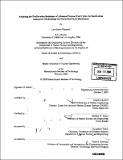| dc.contributor.advisor | Mujid S. Kazimi. | en_US |
| dc.contributor.author | Pierpoint, Lara Marie | en_US |
| dc.contributor.other | Massachusetts Institute of Technology. Dept. of Nuclear Science and Engineering. | en_US |
| dc.contributor.other | Massachusetts Institute of Technology. Engineering Systems Division. | en_US |
| dc.contributor.other | Massachusetts Institute of Technology. Technology and Policy Program. | en_US |
| dc.date.accessioned | 2008-11-07T19:13:23Z | |
| dc.date.available | 2008-11-07T19:13:23Z | |
| dc.date.copyright | 2008 | en_US |
| dc.date.issued | 2008 | en_US |
| dc.identifier.uri | http://hdl.handle.net/1721.1/43186 | |
| dc.description | Thesis (S.M.)--Massachusetts Institute of Technology, Engineering Systems Division, Technology and Policy Program; and, (S.M.)--Massachusetts Institute of Technology, Dept. of Nuclear Science and Engineering, 2008. | en_US |
| dc.description | Includes bibliographical references (p. 124-126). | en_US |
| dc.description.abstract | A methodology to assess proliferation resistance of advanced nuclear energy systems is investigated. The framework, based on Multi-Attribute Utility Theory (MAUT), is envisioned for use within early-stage fuel cycle simulations. Method assumptions and structure are explained, and reference technology cases are presented to test the model. Eleven metrics are presented to evaluate the proliferation resistance of once-through, COmbined Non-Fertile and Uranium (CONFU), Mixed-Oxide (MOX), and Advanced Burner Reactor (ABR) fuel cycles. The metrics are roughly categorized in three groups: material characteristics, material handling characteristics, and "inherent" facility characteristics. Each metric is associated with its own utility function, and is weighted according to the proliferation threat of interest. Results suggest that transportation steps are less proliferation-resistant than stationary facilities, and that the ABR fuel cycle employing reactors with low conversion ratios are particularly safe. Nearly all steps of the fuel cycles analyzed are more proliferation resistant to a terrorist threat than to a host nation threat (which has more resources to devote toward proliferation activities). The open light water reactor (LWR) and MOX cycles appear to be the most vulnerable of all cycles analyzed. CONFU proliferation resistance is similar to that of the ABR with conversion ratios 0.5 and 1.0; these are all approximately in between the values ascribed to LWR/MOX (at the low end) and ABR with conversion ratio zero (with the highest proliferation resistance). Preliminary studies were conducted to determine the sensitivity of the results to weighting function structure and values. Several different weighting functions were applied to the utility values calculated for the once-through and CONFU fuel cycles. The tests showed very little change in the ultimate trends and conclusions drawn from each fuel cycle calculation. These conclusions, however, are far from definitive. Limitations of the model are discussed and demonstrated. Recommendations for improving the model are made, including a call for in-depth evaluation of weighting function structures and values, and an examination of quantitative links between assumptions and utilities. Ultimate conclusions include that the numerical values produced by the analysis are not fully and accurately instructive, and analysts should recognize that the greatest gifts of the assessment may come from performing the investigation. | en_US |
| dc.description.statementofresponsibility | by Lara Marie Pierpoint. | en_US |
| dc.format.extent | 126 p. | en_US |
| dc.language.iso | eng | en_US |
| dc.publisher | Massachusetts Institute of Technology | en_US |
| dc.rights | M.I.T. theses are protected by
copyright. They may be viewed from this source for any purpose, but
reproduction or distribution in any format is prohibited without written
permission. See provided URL for inquiries about permission. | en_US |
| dc.rights.uri | http://dspace.mit.edu/handle/1721.1/7582 | en_US |
| dc.subject | Technology and Policy Program. | en_US |
| dc.subject | Nuclear Science and Engineering. | en_US |
| dc.title | Analyzing the proliferation resistance of advanced nuclear fuel cycles : in search of an assessment methodology for use in fuel cycle simulations | en_US |
| dc.type | Thesis | en_US |
| dc.description.degree | S.M. | en_US |
| dc.contributor.department | Massachusetts Institute of Technology. Department of Nuclear Science and Engineering | |
| dc.contributor.department | Massachusetts Institute of Technology. Engineering Systems Division | |
| dc.contributor.department | Technology and Policy Program | |
| dc.identifier.oclc | 255606078 | en_US |
